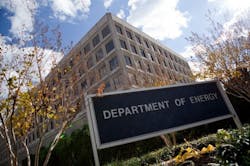"Beneficial Electrification" Mandate provides Holiday Bonus for move to Decarbonize Fed buildings
Officials working to decarbonize energy use at schools and government buildings got an early Christmas president from President Joe Biden.
His 4,600-word executive order of December 8 included a specific mandate to implement “beneficial electrification” at the federal government’s estimated 300,000 buildings. Greenhouse gas emissions from federal buildings will be cut 50% by 2032, and those buildings will be net-zero by 2045, according to the executive order.
That amounts to a large lump of coal in the stockings of fossil-fuel companies that serve Uncle Sam’s buildings. Today, about 40% of federal buildings receive electricity from renewable sources like wind, solar and geothermal, but in many cases, fossil-fueled equipment operates alongside electric-powered equipment.
“Beneficial electrification” is the term used when building owners replace fossil fuel-powered equipment, mostly space heating and water heating (Figure 1, see images in image gallery) with equipment powered by electricity — ideally derived from non-emitting resources.
Around the U.S., dozens of cities and utilities — mostly though not exclusively on the coasts — are working together to implement beneficial electrification. Typically this is done by amending local building codes to prohibit fossil fueled-equipment from being installed in newly constructed buildings — residential, commercial, industrial and institutional — or in buildings undergoing substantial renovation.
Pure-play electric utilities are understandably gung-ho about the new electric load while stand-alone gas utilities are fighting a rear-guard action to protect their markets.
Longer term, the December 8 executive order, which seeks to transform energy industries and the economy by making federal facilities more sustainable, also could be a boost for the fledgling small modular nuclear reactor (SMRs) industry. SMRs sized at about 60 MW could be more than enough to power nearly any federal building, including the Pentagon, though whether nuclear itself was really a “sustainable” source of energy might be grounds for impassioned debate.
Providers of energy efficiency services, including performance contractors that serve U.S. government buildings, also would get a boost from the president’s executive order.
Cities and Schools Actively Working to Decarbonize
The president’s executive order will supplement and strengthen the efforts of officials working at federal, state, and local units of government as well as educational institutions (K-12 and colleges and universities). Many of them have been working for years to reduce the carbon footprint of their buildings and operations, but obtaining the funding to decarbonize is a perennial challenge.
“There is undoubtedly increasing interest among schools and government organizations to decarbonize to help address climate change,” said Brian Jungers, director of mobility for E source, a Boulder, Colorado-based energy research and advisory organization. “Colleges and universities are probably the most vocal on this issue, often driven by student advocacy, though they may also have mandates to decarbonize that are sent down from individual cities or states.”
“Governments tend to follow mandates to decarbonize set at whatever level at which they operate, e.g., federal, state, county, or city,” he continued. “At the federal, state, and city levels, we have seen commitments to reduce carbon emissions and/or increase usage of green power.”
Jungers added that in discussions with one university system that has been particularly active in pursuing sustainability initiatives, officials there said in order to procure renewable natural gas, they would be willing to pay up to three times the going rate for conventional natural gas.
He said the U.S. Environmental Protection Agency (EPA) and the U.S. General Services Administration (GSA) have websites to track and encourage the decarbonization efforts of university systems and federal building energy managers.
University of California: Half-way to Decarb Coals
With an estimated 46% of its electricity coming from green sources, according to the EPA, it would be hard to find a university system more dedicated to decarbonizing than the University of California (UC) system. And yet Matt St. Clair, director of sustainability for the UC Office of the President, said the state-wide university system is only about halfway there.
Following the UC’s adoption of a system-wide carbon neutrality initiative in 2013, he said, the system has reduced greenhouse gas emissions by about 15%, and power purchase agreements (PPAs) for renewable energy have lowered the system’s carbon footprint another 30%. The UC system is huge, comprising 10 campuses, five medical centers and three affiliated national laboratories totaling about 135 million square feet of heated and/or cooled building space.
“We intent to reach carbon neutrality by 2025, admittedly an ambitious goal,” he said in an interview. On a system-wide basis, St. Clair said the goal is to lower energy intensity from nearly 160,000 British thermal units per square foot to about 130,000 Btu/square foot by 2025 (Figure 2, see image gallery).
St. Clair estimated the UC system has invested about $380 million in energy efficiency projects and over $750 million in contract values for renewable energy power purchase agreements (PPAs). He estimated energy savings due to efficiency upgrades since 2004 total $385 million.
“I recommend schools start with energy efficiency — the cheapest and cleanest energy is the energy you don’t use,” he said. “Then, leverage funding from utilities and partners. After that, access case studies on decarbonization from energy managers at other school systems, because you don’t have to reinvent the wheel. Finally, seek funding from sources with a long-term perspective.”
Demand, let me introduce you to supply. In recent years, institutional investors have poured money into “responsible” investments, generally defined as an opportunity that falls into the ESG (Environmental, Social, and Governance) arena. By some estimates, pension funds, banks, private equity funds, sovereign wealth funds, mutual funds and other institutional investors have put at least $120 trillion dollars into “responsible” investments since 2006 (Figure 3, see image gallery).
That sum may rise even further, if investment pledges made at the recent COP26 climate change summit in Glasgow, Scotland, are fulfilled. Not all of that money has been deployed in EV battery factories, windfarms or advanced materials companies. Some of these asset managers may want to help decarbonize college campuses.
A Colorado City Recommends Legislative Action to Drive Decarb Goals
There are lots of reasons — including climate change, air quality and equity — that a city might want to decarbonize its buildings as well as help customers decarbonize theirs, according to Jonathan Koehn, interim director of the climate initiatives department at the city of Boulder, Colorado. But he said given the price runup in natural gas this year, plain old financial risk management should be added to the pile.
“Our dependence on gas appliances creates significant financial vulnerability for our community,” he said in an email interview. “Events earlier this year show just how volatile gas prices can be. When layered on top of already increasing commodity costs, gone are the days where natural gas is our most affordable energy option. If we are going to stabilize the cost of energy for our most vulnerable, we need to look to clean, electric solutions.”
He said Boulder has for years pursued a multi-pronged approach to decarbonizing its energy supply. “This includes our decade-long effort to explore forming our own municipal electric utility. In parallel to municipalization, we have also had a strong policy and regulatory focus” to advance decarbonization through state legislation.
The city set a goal of 100 MW of local renewable generation by 2030 (it has about 68 MW in place now) and is working with its electricity provider, Xcel Energy, “to explore strategies that could help accelerate realization of their goal for a zero-emission grid, and in doing so, highlighting the importance of existing and emerging technologies and tactics that pair with community-based objectives.”
Boulder has supported renewable distributed generation through “aggressive” rebates and incentives, a solar grant program for non-profits and low-income customers, and created unique pathways for increased adoption, Koehn said.
The city provides about $500,000 annually in rebates and grants to residents and businesses to support efficiency, electrification, and solar adoption. The city also reinvests sales tax dollars in grants to lower-income residents and non-profit businesses to cover up to 50% of the cost of solar.
With recreational use of marijuana legal in 18 states and the District of Columbia, and medical use permitted in 36 states, pot has become a big business, which carries significant implications for cities concerned about electricity, water and greenhouse gas emissions.
Koehn noted that industrial marijuana cultivation often relies on a complex and energy-intensive system — requiring enough electricity to comprise 2% of Boulder’s total energy use and 1.3% of Colorado’s annual emissions. Grow lighting and the heating and cooling of indoor grow facilities drive up energy use. This energy demand is greater in states like Colorado that have variable climates and require more electricity to heat or cool air.
“The city and county reduce the industry’s carbon footprint through regulations that require local cannabis businesses to track, report and offset 100% of their electricity use,” he said. “Businesses can complete the offset requirement by installing solar on-site, subscribing to a verified local solar garden or purchasing offsets through the city’s Energy Impact Offset Fund (EIOF).
Looking Forward
As energy managers at governmental or educational bodies continue their efforts to decarbonize, they can move forward knowing they have a friend in the White House. Peer organizations that have been working to decarbonize their building and operations for a decade or more can offer valuable experience. The rise of ESG investing may help address the perennial challenge of cost. Following a harrowing 2021, with its string of deadly, expensive natural disasters caused or made worse by climate change, a growing number of elected officials may be more receptive to implementing rules or taking steps to reduce greenhouse gas emissions.
That doesn’t mean corporate energy managers at governments or educational systems have it easy. Decarbonization in a lengthy, expensive, and complex process, filled with interdependencies and surprises. Best to approach it with the wisdom of the Chinese philosopher Lao Tzu: “A journey of 1,000 miles starts with a single step.”
- - -
(About the author: John Egan is founder and president of Egan Energy Communications. He has more than 30 years of experience with the energy and utility sectors).





